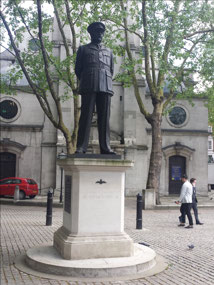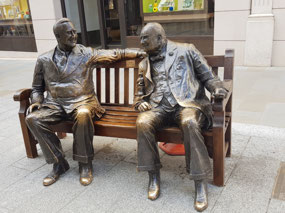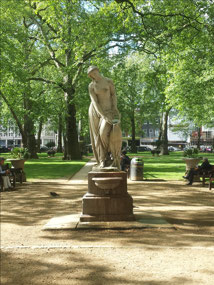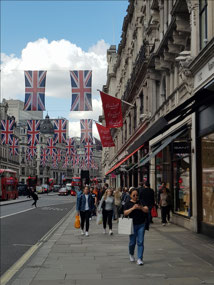Highlights St Clement Danes .
Today was small jobs day. We contributed to the household on
line order for food stuffs, then walked to the nearby tube station to add money
to our oyster cards. They told us we were in debit after our trip to Gatwick so
it was good we had not tried to use them straight away. We then walked on to a
bank to trade our ‘old’ notes for new ones, which was no problem to do. Then we
headed for the tube to take a line to St Clement Danes.
This is now also known as the Central Church of the RAF. A
brief history first. It was originally called St Clements and then
St-Clement-of-the-Danes after Danish settlers with English wives settled in the
area. The church was rebuilt after the Great Fire of London although it was not
actually affected by the fire but was just very run down. In 1941 it received a
direct hit from a bomb which destroyed all but the outer walls and tower.
In1958 restoration was completed and it was reconsecrated as the Central Church
of the Royal Air Force.
We found the hand carved slate memorial to Ted’s 214 squadron
and then had a quiet wander around the church. Outside John took more photos
including those of Dowding and Bomber Harris, while I found a cache that had
been placed to acknowledge this church.
We had decided to walk to
Hamley’s rather than bus or tube. It was a cooler day so walking was pleasant
and we could see the sights. The route took us close to another church, the
Queen’s Chapel of the Savoy.
It was tucked away on a side street and we only
saw it because of caching. The listing told us about it.
A
palace was built on the Savoy estate in the fourteenth century by John of
Gaunt, and it was plundered and burned in 1381 during the Peasants’ Revolt. What
was left of it was cleared away in the early sixteenth century by command of
King Henry VII to construct a foundation known as the ‘Hospital of Henry, late
King of England of the Savoy’. The hospital was a charitable foundation to
provide a night’s lodging for 100 ‘pour and nedie’ men. Engravings of the
hospital show an extensive complex of buildings, including a great dormitory,
longer than Westminster Hall, and three chapels, dedicated to St John the Baptist,
St Catherine and Our Lady. The hospital foundation was dissolved in 1702, and
most of the complex was demolished in the early nineteenth century for
redevelopment and to allow the construction of the approach road to the new
Waterloo Bridge. All that survives today is the Chapel of St John the Baptist,
now known as The Queen’s Chapel of the Savoy.
We
thought this might be a church that Jane didn’t know about. She had not only
heard of it but she could tell us a bit more. Military officers are allowed the
use of the church and a friend of hers had the christening of his triplets in
this chapel.
We
next stopped in Trafalgar Square to look at the various buskers and pavement
artists. Then we went to the 4th plinth to see what was now on
display. Not our favourite display we decided, although the sentiment displayed
was fine.
Our
next stop was Piccadilly Circus as we were a bit footsore by now. A short sit-down
on the steps was all we needed before heading to Hamley’s. John always has a
new lease on life in here and we had a lot of fun looking at the various
displays. As usual they had a number of staff demonstrating various new toys,
so things were flying around the store and children were trialling various pens
that squiggled and trains that went around short tracks. There is now a large
section for Harry Potter and ‘the Lord of the Rings’ as well.
After
a late pub lunch we made our way to Berkeley Square, trying not to sing about
nightingales on the way. The target was house number 50, which has been called
the most haunted house in London as well as the oldest unaltered building. Supposedly
the attic room is haunted by the spirit of a young woman who committed suicide
there. She apparently threw herself from a top-floor window after being abused
by her uncle and is said to be capable of frightening people to death. From
1859 until the early 1870s Mr Myers, who had been rejected by his fiancée,
lived in the house. It was said that he locked himself inside and slowly went mad.
In 1879 a report in the Mayfair Magazine alleged that a maid who stayed in the
attic room had been found mad and had died in an asylum the day after. It was
also alleged that after a nobleman spent the night in the attic room he was so
paralysed with fear that he could not speak.
Finally, in 1887, it was alleged that two sailors from HMS Penelope stayed a
night in the house. By morning one was found dead, having tripped as he ran
from the house. The other reported having seen the ghost of Mr Myers
approaching them aggressively.
The house seemed normal to us but the area was lovely and the history interesting.
The house seemed normal to us but the area was lovely and the history interesting.
It
was time now for home, so we headed to the tube for a direct connection to
Shepherd’s Bush. We walked home with a side step to a market, but it was too
late to buy asparagus. Instead we bought some from Jane and Ian’s local store and
enjoyed it for tea while they went out for the evening.

 London, England, United Kingdom
London, England, United Kingdom








2025-05-22